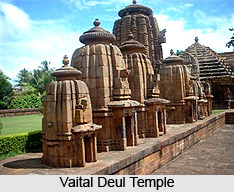 Vaital Deul Temple, located in Bhubaneshwar city of Odisha, is an 8th century Hindu temple dedicated to Goddess Chamunda. The temple is locally famed as `Tini Mundia Mandira`. It is a Sakta shrine. Tantric associations of the temple further augment its fame. The sanctum of the temple houses eerie carvings. In front of the assembly hall called jagmohana, sacrificial offerings have been found tied to a stone post which adds to the tantric character of the temple. Artificial lights are required for illuminating the dark interiors of the temple for having a clear view of the temple architecture.
Vaital Deul Temple, located in Bhubaneshwar city of Odisha, is an 8th century Hindu temple dedicated to Goddess Chamunda. The temple is locally famed as `Tini Mundia Mandira`. It is a Sakta shrine. Tantric associations of the temple further augment its fame. The sanctum of the temple houses eerie carvings. In front of the assembly hall called jagmohana, sacrificial offerings have been found tied to a stone post which adds to the tantric character of the temple. Artificial lights are required for illuminating the dark interiors of the temple for having a clear view of the temple architecture.
Architecture of Vaital Deul Temple
The shape of the sanctuary tower is the most striking feature of Vaital Deul Temple. It belongs to the Khakhara order of temples which is represented by the semi cylindrical shape of its roof. It also bears resemblance with the Dravidian gopuram of the South Indian temples. The jagamohana of the temple has a rectangular shape and its deul has an oblong plan. At each of the angle, a small subsidiary shrine is embedded. Perfect equipoise and delicate features of the figures over the relief of the temple are quite admirable. Panels of Hindu deities can be observed on the outer walls including Shiva and his consort Parvati in her Shakti form, wild elephants, hunting processions and erotic couples.
 Two chaitya windows are there on the facade of the deul above the left of jagamohana. Magnificently carved figure of sun god Surya can be seen in the lower one which is renowned for its facial expression. Along with it, there are also the figures of Usha (Dawn) and Pratyusha, on a chariot of seven horses driven by Aruna, shooting arrows on either side. The upper chaitya-window is adorned with a 10-armed Nataraja. Jagamohana is flat roofed, in front of which there is a stone post having two Buddha like figures seated in dharma-chakra-pravartana mudra.
Two chaitya windows are there on the facade of the deul above the left of jagamohana. Magnificently carved figure of sun god Surya can be seen in the lower one which is renowned for its facial expression. Along with it, there are also the figures of Usha (Dawn) and Pratyusha, on a chariot of seven horses driven by Aruna, shooting arrows on either side. The upper chaitya-window is adorned with a 10-armed Nataraja. Jagamohana is flat roofed, in front of which there is a stone post having two Buddha like figures seated in dharma-chakra-pravartana mudra.
Deities of Vaital Deul Temple
The idol of the presiding deity, eight armed Chamunda, is enshrined in the central niche and is decorated with a skull garland. The Goddess is seated on a corpse flanked by a jackal and an owl. Chamunda is the terrifying form of Goddess Durga and is locally called Kapalini. She also holds a thunderbolt, an arrow, a trident, a sword, a shield, a bow, a snake and pierces the neck of the demon. A "chaitya" window caps the niche having seated images of Shiva and Parvati. A group of other allied deities surrounds Chamunda with their images carved on the lower parts of the wall. Each figure is carved in a separate niche parted by a pilaster. The east wall houses a skeleton form of Bhairava which is the counter part of Chamunda. Another figure is carved on the north wall which rises from the ground with his skull cup filled with the blood of a person whose severed head lies on the right. Figures of an offering of two more heads on tray placed on a tripod can be spotted on the pedestal. It is flanked by a woman holding a head on the left and a jackal savouring the decapitated body on the right.





















